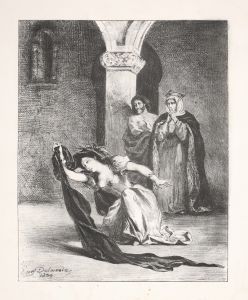
Monomaniac of Envy
A hand-painted replica of Théodore Géricault’s masterpiece Monomaniac of Envy, meticulously crafted by professional artists to capture the true essence of the original. Each piece is created with museum-quality canvas and rare mineral pigments, carefully painted by experienced artists with delicate brushstrokes and rich, layered colors to perfectly recreate the texture of the original artwork. Unlike machine-printed reproductions, this hand-painted version brings the painting to life, infused with the artist’s emotions and skill in every stroke. Whether for personal collection or home decoration, it instantly elevates the artistic atmosphere of any space.
Théodore Géricault's painting Monomaniac of Envy is one of a series of works created by the French Romantic artist in the early 1820s. This series, commonly referred to as the "Monomaniacs" or "Portraits of the Insane," consists of five known portraits depicting individuals suffering from various forms of mental illness. These works were commissioned by Dr. Étienne-Jean Georget, a pioneering psychiatrist of the time, who sought to use art as a means of studying and documenting mental disorders.
Monomaniac of Envy portrays a woman believed to be afflicted with monomania, a psychological condition characterized by an obsessive focus on a single idea or emotion. In this case, the subject is thought to embody envy, as suggested by the title. Géricault's depiction is notable for its unflinching realism and empathetic approach, avoiding caricature or exaggeration. The woman is shown with a somber expression, her gaze distant and introspective, capturing the emotional depth and humanity of her condition.
The painting is executed in oil on canvas and demonstrates Géricault's mastery of portraiture. His use of muted tones and careful attention to detail emphasize the psychological state of the subject. The background is plain and unadorned, drawing the viewer's focus entirely to the figure. This minimalist approach aligns with the scientific intent of the series, as it avoids distractions and highlights the individual's features and expression.
The "Monomaniacs" series reflects Géricault's interest in the human condition and his engagement with contemporary medical and psychological theories. It also aligns with the Romantic movement's broader fascination with emotion, individuality, and the darker aspects of human experience. These works stand apart from Géricault's more famous large-scale paintings, such as The Raft of the Medusa, but they are equally significant in showcasing his versatility and depth as an artist.
Today, Monomaniac of Envy and the other portraits in the series are considered important contributions to both art and the history of psychiatry. They provide insight into 19th-century attitudes toward mental illness and demonstrate how art can intersect with science to explore complex aspects of human life. The current location of Monomaniac of Envy is not definitively established, as some of the paintings in the series are held in private collections or remain untraced.


















